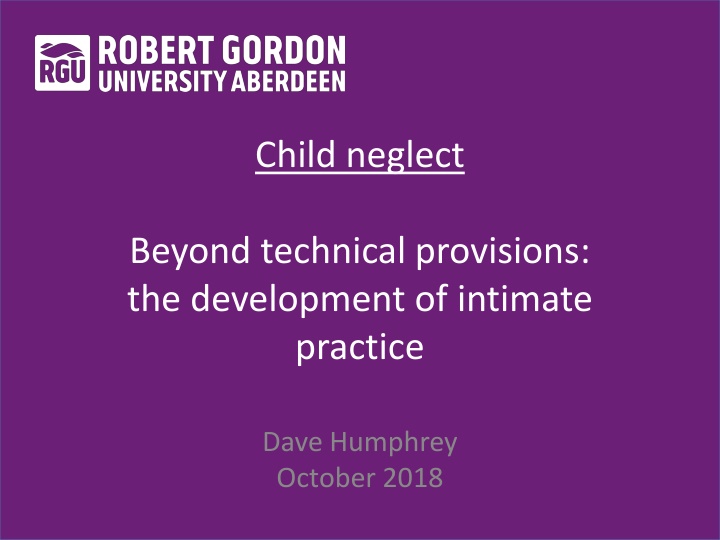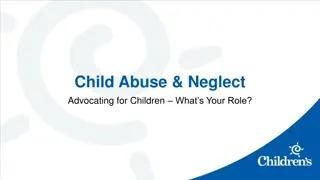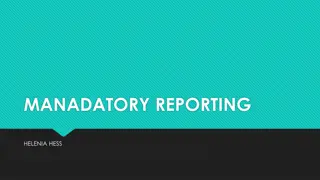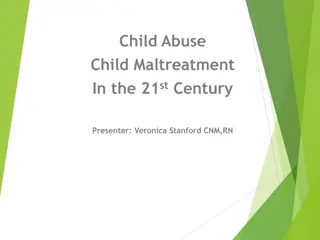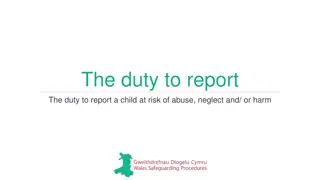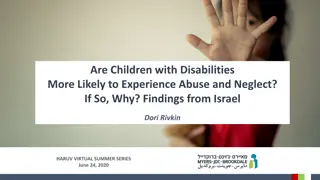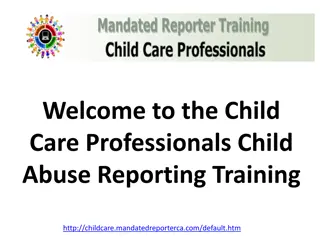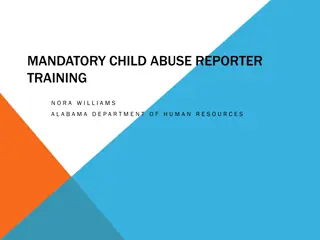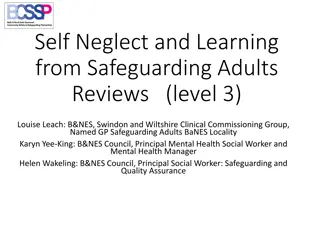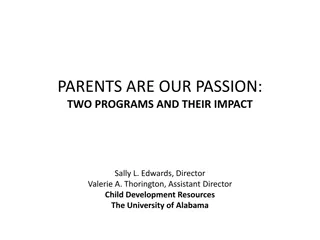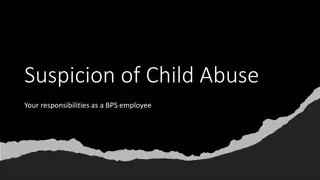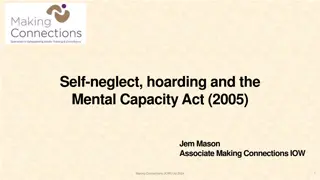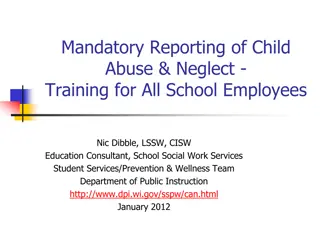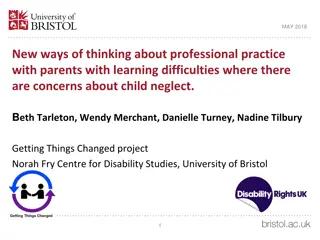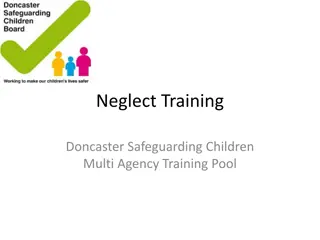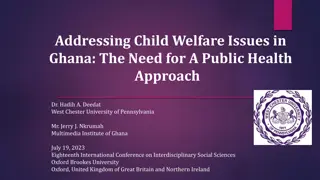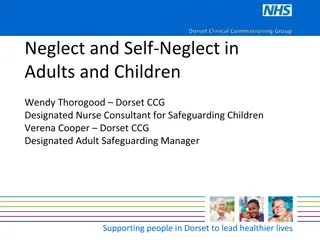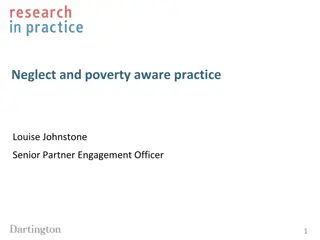Child Neglect: Beyond Technical Provisions
Child neglect is a phenomenon shaped by its social context, requiring more than just technical solutions. Good practice involves understanding the complex lives of children and addressing persistent difficulties in protecting them. Characteristics of neglect include a focus on the child's presentation, chronic nature, persistence, confidence issues in professional judgement, and multi-type maltreatment. Visiting homes to raise child protection concerns is both professionally and personally challenging, requiring courage, skill, and resilience.
Download Presentation

Please find below an Image/Link to download the presentation.
The content on the website is provided AS IS for your information and personal use only. It may not be sold, licensed, or shared on other websites without obtaining consent from the author.If you encounter any issues during the download, it is possible that the publisher has removed the file from their server.
You are allowed to download the files provided on this website for personal or commercial use, subject to the condition that they are used lawfully. All files are the property of their respective owners.
The content on the website is provided AS IS for your information and personal use only. It may not be sold, licensed, or shared on other websites without obtaining consent from the author.
E N D
Presentation Transcript
Child neglect Beyond technical provisions: the development of intimate practice Dave Humphrey October 2018
is a phenomenon shaped by its social context, It is quite unlike a specific disease entity, such as measles, where it is hoped an understanding of its cause and treatment that has universal application can be delivered. (Munro 2011 5)
Technical competence 40+years of case reviews, research and knowledge development have informed and advanced our care and protection processes Technical/rational solutions evidence only limited success (Gillingham & Humphreys, 2010) Adherence to bureaucratic process & technical rationale does not, in itself equate to effective practice (Munro 2011)
http://tse1.mm.bing.net/th?id=OIP.M7cbb807c10bf9f9834acd66dee2554b8H0w=299h=194c=0pid=1.9rs=0p=0r=0http://tse1.mm.bing.net/th?id=OIP.M7cbb807c10bf9f9834acd66dee2554b8H0w=299h=194c=0pid=1.9rs=0p=0r=0
good practice is about doing the simple things properly (Laming 2003: 2015) However, thematic analysis of SCR s highlights consistent and continued difficulties in fully understanding the complex lives of children there is an extraordinarily persistent difficulty in seeing, listening to and understanding the experience of children (Rustin 2005: 20)
Characteristics of neglect 1. Professional focus on presentation of the child 2. Chronic, rather than acute nature 3. Persistent and ongoing 4. Confidence issues - professional judgement 5. Multi-type maltreatment (Farmer and Lutman 2014)
Visiting a home and raising child protection concerns is professionally and personally challenging (Turnell and Edwards 1999) The unpredictability of physical spaces (Ruch 2014) Uniquely intimate environment it takes a clear understanding of the child protection role, the importance of good authority, and great courage, skill and resilience to go through what is required to protect children (Ferguson, 2011 7)
Neglect filter Professional inertia False/ disguised compliance Professional enmeshment The rule of optimism Psychoanalytic perspective
Neglect filter Not knowing how best to help can create a neglect filter which enables neglect to be screened out with thoughts such as it s not that bad really or they are happy underneath it or I ve seen worse. (Daniel et al 2011:16)
Professional inertia Values and assumptions > belief in needy families belief that neglect is less harmful than other forms of abuse fear of value expectation and imposition dominant belief in the socio-economic cause (Action for children)
Disguised/ false compliance Parental participation is not the same as cooperation Sometimes, during cycles of intermittent closure, a professional worker would decide to adopt a more controlling stance. However, this was defused by apparent co-operation from the family. We have called this disguised compliance because its effect was to neutralise the professional s authority and return the relationship to closure and the previous status quo. (Reder et al, 1993, pp 106-7). Need for respectful uncertainty (Laming 2003) 1. 2. Professionals playing devils advocate The need for a fresh pair of eyes in a case (Munro 2008)
Professional enmeshment Laird (2013) shows the high levels of conflict and resistance in child protection work that result in workers either avoiding or over-identifying with parents and losing focus Porous and indistinguishable boundaries Boundaries are the limits that allow for a safe connection based on the client s needs (Peterson, 1992, p. 74) workers avoid robust challenge of parents by emphasising their strengths (Ofsted 2010)
The rule of optimism We want to believe we are making a positive difference ( helping professions) This is a tendency by social workers and healthcare workers towards rationalisation and under-responsiveness in certain situations. In these conditions, workers focus on adults strengths, rationalise evidence to the contrary and interpret data in the light of this optimistic view. They confuse participation by parents with cooperation (Coventry LCSB,2013, p. 46) rationalises evidence that contradicts progress 1. natural love 2. cultural relativism (Dingwall, Eekelaar and Murray 1995) Note hindsight bias (discourse of SCR s?)
Confirmation bias the tendency to accept beliefs that match preferred views (Gambrill 2012) does not arrive empty-minded in the field. S/he brings to his of her study a set of foreshadowed problems, hypotheses in the making and hunches to be followed and reflected on (Malinowski 1933 p 46) Satisficing (Helm 2011) Cultural normalisation & professional de-sensitivity Labelling & stigmatisation
Psychoanalytic perspective Recognises the role of unconscious defence mechanisms Denial, rationalisation (Freud) the systematic disconnection between things which logically belong together is a defence mechanism, protecting us from the intense feelings stirred up by exposure to human cruelty (Rustin 2005: 12)
Non-intimate practice Children at the centre aspirational rhetoric or practice reality? Intimacy has developed sexual connotations that has distorted and narrowed the broader relational value of the term Touch a discourse of paranoia (Piper, Powell and Smith 2006) Automated relational pattern Limited opportunity to engage in direct work (Munro 2011) Not effectively moving towards, seeing, hearing or touching children (Ferguson 2011)
A move towards intimate practice Underpinned by therapeutic ethic of care Relationships (getting close) Skilled communication Acknowledging the centrality of play Use of self Holding emotional suffering of the child
Helping children is a human process. When the bureaucratic aspects of work become too dominant, the heart of the work is lost (Munro 2011: 10)
References (1) ACTION FOR CHILDREN,. 2012. Working with neglect: Practice toolkit. Action for Children. BELL, M., 1999. Working in partnership in child protection: the conflicts. British Journal of Social Work, 437, pp 437- 455. CALDER, M., 2008. Contemporary risk assessment in safeguarding children. Lyme Regis: Russell House Publishing. COVENTRY LOCAL SAFEGUARDING BOARD., 2013 Daniel Pelka Serious Case Review. DANIEL, B, TAYLOR J. and SCOTT J.(2011). Recognising and helping the neglected child: evidence based practice for assessment and intervention. London: Jessica Kingsley Publishers. DINGWALL, R, EEKELAAR, J and MURRAY., T 1995 The protection of children : state intervention and family life. Aldershot: Quid Pro Books. FARMER, E and LUTMAN E., 2014. Working effectively with neglected children and their families what needs to change? Child Abuse Review, 23, pp 262-273. FERGUSON, H., 2011. Child protection practice, London: Palgrave MacMillan. FORRESTER, D., MCCAMBRIDGE, J., WAISSEIN, C. and ROLLNICK, S., 2008. How do child and family social workers talk to parents about child welfare concerns?, Child Abuse Review, 17 (1), pp 23-25. GAMBRILL, H., 2012., Social Work Practice: A Critical Thinker's Guide. OUP USA. GILLINGHAM, P. and HUMPHREYS, C., 2010. Child Protection Practitioners and Decision-Making Tools: Observations and Reflections from the Front Line. British Journal of Social Work 40 (8), pp 2598-2616. HELM, D., 2011. Making Sense of Child and Family Assessment: How to Interpret Children s Needs, London: Jessica Kingsley Publishers. HOGGETT, P., et al., 2006. Identity, life history and commitment to welfare. Journal of Social Policy, 35 (4). pp. 689- 704. LAIRD, S., 2013. Child Protection Managing Conflict, Hostility and Aggression. Bristol: Policy Press. LAMING, L., 2003.The Victoria Climbie Inquiry: Report. London: Government Publications. MORRIS, K., 2010. Children in need: the challenge of prevention for social work in Ayre,
References (2) MUNRO, E., 2008. Effective Child Protection, London: Sage. MUNRO, E., 2011. The Munro Review of Child Protection: Final Report A child-centred system. Department for Education. OFSTED., 2010. Learning Lessons from Serious Case Reviews, 2009 2010, London, Government Publications. PETERSON, M., 1992. At personal risk: Boundary violations in professional client relationships. New York: W.W. Norton. PIPER, H., POWELL, P and SMITH, H., 2006. Parents, Professionals, and Paranoia: The Touching of Children in a Culture of Fear. Journal of Social Work. 6(2), pp 151 167. PLATT, D., 2007. Investigation or Initial Assessment of Child Concerns? The impact of the refocusing initiative on social work practice. British Journal of Social Work 36, pp. 267-281. REDER, P., DUNCAN, S. and GRAY, M., 1993. Beyond blame: child abuse tragedies revisited. London: Routledge. RUCH, G., 2014 Helping children is a human process: Researching the challenges social workers face in communicating with children, British Journal of Social Work, 44, 8, pp. 2145 62. RUSTIN, M., 2005. Conceptual Analysis of Critical Moments in Victoria Climbie s Life. Children and Family Social Work, 10, pp 11-20. SCOTTISH GOVERNMENT., 2014. National Guidelines for Child Protection in Scotland. [online]. Available from http://www.gov.scot/Resource/0045/00450733.pdf [accessed 1/02/18] SIDEBOTHAM, P, et al., 2016. Pathways to harm, pathways to protection: a triennial analysis of serious case reviews 2011 to 2014. London, Department for Education. TURNELL, A and EDWARDS, S., 1999. Social Work Skills: A Practice Handbook, 2ndedn, Maidenhead: Open University Press. WESTCOTT, H.,1995. 'Perceptions of child protection casework: views from children, parents and practitioners', in Cloke, C. and Davies, M. (eds) Participation and Empowerment in Child Protection, London, Pitman.
